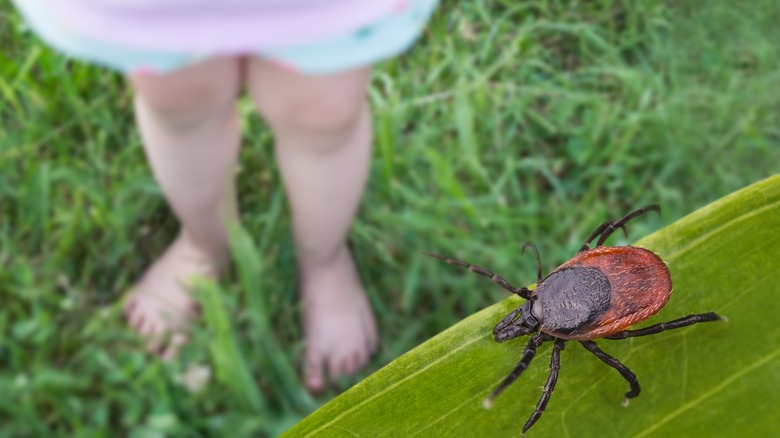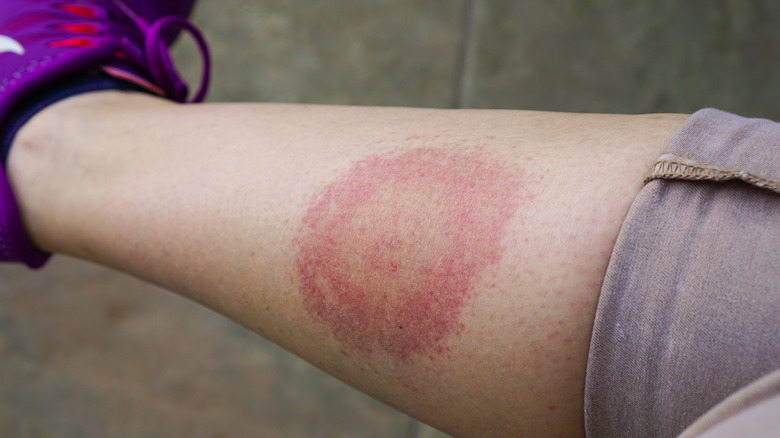Yolanda Hadid's Experience With Lyme Disease Explained
There is no way to measure the true extent of Lyme disease in the U.S., as doctors commonly misdiagnose or dismiss symptoms altogether. Global Lyme Alliance calls Lyme disease "The Great Imitator," as symptoms often resemble other common health conditions. There is no accurate diagnostic test for Lyme disease, meaning many patients suffer in silence or work for years to get a diagnosis and subsequent treatment plan. No known medical cure exists for those who manage to get a diagnosis, although effective treatments are available.
According to Dr. Darin Ingles at LDN Research Trust, Lyme disease is the fastest-growing infectious disease in the world. Ingles says the United States sees 400,000 new cases of Lyme disease each year, with 85,000 new cases reported in Europe annually. The Centers for Disease Control and Prevention (CDC) says the number of Lyme cases in the U.S. is likely even higher, with recent estimates clocking in at 476,000 new cases yearly. Recently, some celebrities have been speaking out about their experience with Lyme disease, a controversial illness that the U.S. healthcare system has largely dismissed. Former model and reality TV star Yolanda Hadid opened up about her epic struggle with chronic Lyme disease (CLD) in an interview with Vogue.
Yolanda Hadid calls Lyme disease an invisible disability
The "Real Housewives of Beverly Hills" cast member calls Lyme disease an "invisible disability," as symptoms are primarily internal, with little to no external manifestation. Add to that the difficulty getting a diagnosis, absence of a cure, and lack of media attention, and you have a perfect storm born of shame and prolonged suffering. "Like with many chronic diseases and mental health issues, the unfortunate truth is that you appear to be healthy on the outside, which is difficult for people to reconcile," Hadid tells Vogue. "It's much easier for us to have compassion for somebody with visible external symptoms. Most people still don't seem to believe that chronic Lyme disease even exists. As the saying goes: you don't truly get it until you get it."
Yolanda Hadid is mother to models Gigi, Bella, and Anwar Hadid, and both Bella and Anwar have also been diagnosed with Lyme disease. The family struggled to get an accurate diagnosis and find effective treatments for 10 years before finding relief. "My decade-long journey was an absolute nightmare, but my diagnosis taught me a lot about life; about how much patience and dedication are needed in order to survive," Hadid told Vogue.
Hadid lived on a farm but never noticed a tick bite
Lyme disease is an infection caused by one of four different types of bacteria (per Mayo Clinic). Borrelia burgdorferi and Borrelia mayonii are the main strains of Lyme in the United States, while Borrelia afzelii and Borrelia garinii are most common across Europe and Asia. Unlike many infectious diseases, Lyme disease is not known to spread from person to person. Instead, people typically contract the bacterial infection through a bite from a tiny, black-legged tick called a deer tick.
You're more likely to contract Lyme disease after spending time in wooded surroundings like forests and grassy areas where these ticks thrive, but you could encounter an infected tick elsewhere as well. Their small size and painless bite make it hard to spot deer ticks on the body, and people often have trouble pinpointing the exact source of Lyme disease, even if they manage to get a proper diagnosis. "My children grew up on a farm in Santa Barbara, California, riding horses and spending a lot of time in nature," Hadid tells Vogue. "We never noticed any ticks or bull's-eye rashes on us, but we'll never know for sure."
Lyme disease symptoms mimic other common diseases
Getting a diagnosis for Lyme disease can be tricky, and confounding symptoms can be extremely frustrating for people with the condition. The Mayo Clinic says Lyme disease symptoms appear in stages, although symptoms may overlap. The first sign of Lyme disease often appears as a reddish bulls-eye rash called erythema migrans. The rash is usually not painful or itchy, but it may feel warmer to the touch than the rest of the skin. This rash can spread up to 12 inches in diameter and may occur at one site or in multiple places on the body. However, some people never get the rash.
Other early symptoms may include a fever with chills, body aches, headaches, fatigue, stiffness in the neck, and swollen lymph nodes. These first-stage symptoms usually begin three to 30 days after infection. Later symptoms occur in the following weeks or months and may include severe joint pain and swelling, especially in the knees. However, pain may shift from one area to another.
Bell's palsy may cause temporary facial paralyzation, and impaired muscle function may lead to numbness or weakness in the arms and legs. Inflammation may occur in the eyes or liver, and the heartbeat may become irregular. Inflammation of the tissues surrounding the brain can cause meningitis, leading to confusion, inability to concentrate, lack of appetite, nausea and vomiting, seizures, and light sensitivity (per Mayo Clinic).
Chronic Lyme disease remains controversial in the U.S.
"My symptoms included severe fatigue, brain fog, memory loss, difficulty with word retrieval, anxiety, insomnia, migraines, joint pain, muscle weakness, intolerance to bright light, flu-like symptoms, swollen lymph nodes, and slight Bell's palsy in my face — all of which left me feeling depressed," Hadid told Vogue. Depression and other neuropsychiatric symptoms are common in those unable to get Lyme disease symptoms under control.
The Lyme Disease Association lists depression, mood swings, irritability, personality changes, panic attacks, paranoia, and hallucinations among the effects associated with Lyme disease. Global Lyme Alliance says that since no accurate diagnostic test exists, many patients are diagnosed based on a combination of symptoms. Symptoms can be vague or resemble those of other health conditions, including Multiple Sclerosis (MS), amyotrophic lateral sclerosis (ALS), Alzheimer's, fibromyalgia, rheumatoid arthritis (RA), and chronic fatigue, often leading to misdiagnoses (per iGeneX).
Chronic Lyme disease (CLD) is not recognized by much of the medical industry in the U.S., making it nearly impossible for some patients to get a diagnosis from American doctors (via Prevention). Doctors claim a round or two of antibiotics should kill Lyme disease. However, antibiotics don't work for many patients whose symptoms may fade and recur multiple times. "I fought tooth and nail to keep things together in front of my family and friends, but as things got progressively worse, there was no hiding from the truth anymore," Hadid told Vogue. "I was eventually diagnosed by a doctor in Belgium."
Hadid advocates for chronic Lyme disease awareness
The lack of accurate testing and the U.S. medical industry's controversial stance on chronic Lyme disease (CLD) can make life hellish for people with CLD. Living without a cure or even a diagnosis can eventually lead some to contemplate suicide, explains Vogue.
"I can't begin to describe the darkness, the pain and the hell I lived through every day," Hadid told the publication. "For some time, it didn't even feel like living at all. This disease brought me to my knees. Many nights I wished to die, and prayed I would just be free of the pain. If it weren't for my children, I don't think I would be here today. It's so important we learn to listen to people, as many of us are suffering in silence. We should learn not to judge how somebody feels by the way they look on the outside."
Hadid used her struggles to help others deal with the issues she faced in seeking diagnosis and treatment. She penned her book, "Believe Me," to offer hope for people who feel like they're battling the disease alone. Hadid's message to those facing CLD is one of empowerment and unity. "My heart is filled with compassion and respect for each and every person courageously battling this life-altering disease. Remember: you are not alone. We must continue to fight this, together, one day at a time until a cure is found that is both accessible and affordable to all."






